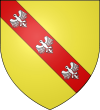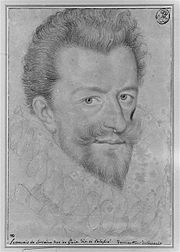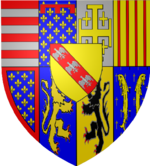- Henry I, Duke of Guise
-
Henry I, Prince of Joinville, Duke of Guise, Count of Eu (December 31, 1550 – December 23, 1588, Château de Blois), sometimes called Le Balafré, "the scarred", was the eldest son of Francis, Duke of Guise, and Anna d'Este. His maternal grandparents were Ercole d'Este II, Duke of Ferrara and Renée of France.
Contents
Life
He succeeded his father in 1563 as Duke of Guise and Grand Maître de France. He fought the Turks in Hungary in 1565, and on his return, he became one of the leaders of the Catholic faction in the French Wars of Religion. He fought at the Battle of Saint-Denis in 1567, and at Battle of Jarnac and Battle of Moncontour. His courting of Margaret of Valois in 1570 offended her brother, Charles IX of France, but his marriage to Catherine of Cleves restored his fortunes. Considering the Huguenot leader Admiral Coligny the architect of his father's assassination during the siege of Orléans in 1563, he is a suspect in the murder of the Admiral in August 1572. Which was quickly followed by the St. Bartholomew's Day Massacre.
Henry was wounded at the Battle of Dormans (October 10, 1575), and was thereafter known, like his father, as "Le Balafré". With a charismatic and brilliant public reputation, he rose to heroic stature among the Catholic population of France as an opponent of the Huguenots.
In 1576 he formed the Catholic League to keep the new heir, the Protestant Henry of Navarre, off the throne. The talent and dash of Guise contrasted favorably with the vacillation and weakness of Henry III. He was said to have claimed a Carolingian descent and cast eyes on the throne. This led to the stage of the Wars of Religion known as the War of the Three Henries (1584–1588).
However, at the death in 1584 of Francis, Duke of Anjou, the king's brother (which left Henry of Navarre, the Protestant champion, as heir-male), Guise concluded the Treaty of Joinville with Philip II of Spain. This compact declared that the Cardinal de Bourbon should succeed Henry III, in preference to Henry of Navarre. Henry III now sided with the Catholic League (1585), which made war with great success on the Protestants. Guise sent his cousin Charles, Duke of Aumale to lead a rising in Picardy (which could also support the retreat of the Spanish Armada). Alarmed, Henry III ordered Guise to remain in Champagne; he defied the king and on May 9, 1588 Guise entered Paris, bringing to a head his ambiguous challenge to royal authority in the Day of the Barricades and forcing King Henry to flee.
The League now controlled France; the king was forced to accede to its demands and created Guise Lieutenant-General of France. But Henry III refused to be treated as a mere cipher by the League, and decided upon a bold stroke. On December 23, 1588, at the Château de Blois, Guise was summoned to attend the king, and was at once assassinated. His brother Louis II, Cardinal of Guise was assassinated by "the Forty-five", the king's bodyguard, the next day. The deed aroused such outrage among the remaining relatives and allies of Guise that Henry III was forced to take refuge with Henry of Navarre. (Henry III was assassinated the next year by Jacques Clément, an agent of the Catholic League.)
According to Baltasar Gracian in A Pocket Mirror for Heroes, it was once said of him to Henry III, "Sire, he does good wholeheartedly: those who do not receive his good influence directly receive it by reflection. When deeds fail him, he resorts to words. There is no wedding he does not enliven, no baptism at which he is not godfather, no funeral he does not attend. He is courteous, humane, generous, the honorer of all and the detractor of none. In a word, he is a king by affection, just as Your Majesty is by law."
In literature and the arts
Literature
The Duc de Guise appears as an archetypal Machiavellian schemer in Christopher Marlowe's The Massacre at Paris, which was written a few years after the St. Bartholomew's Day massacre. The death of the duke is also mentioned, by the ghost of Machiavelli himself, in the opening lines of The Jew of Malta.
He is one of the characters in Alexandre Dumas's novel La Reine Margot.
Stanley Weyman's novel A Gentleman of France includes the Duke of Guise in its tale about the War of the Three Henries.
Film
L'Assassinat du Duc de Guise, Op. 128, first shown at the Salle Charras in Paris on 16 November 1908, was the first film to include a score written by a well-known classical composer, Camille Saint-Saëns.
The duke also has a role in D.W. Griffith's 1916 film Intolerance, part of which covers the lead-up to the St. Bartholomew's Day Massacre.
The Duke of Guise plays a significant role in the French movie The Princess of Montpensier. He also appears in the both the 1954 version and 1994 version of La Reine Margot.
Ancestors
Ancestors of Henry I, Duke of Guise 16. Frederick VI, Count of Vaudémont 8. René II, Duke of Lorraine 17. Yolande of Anjou 4. Claude, Duke of Guise 18. Adolf, Duke of Guelders 9. Philippine of Guelders 19. Catherine de Bourbon 2. Francis, Duke of Guise 20. Jean VIII, Count of Vendôme 10. François, Count of Vendôme 21. Isabelle de Beauveau 5. Antoinette de Bourbon 22. Peter II de Luxembourg, Count of St. Pol 11. Marie de Luxembourg 23. Marguerite of Savoy 1. Henry I, Duke of Guise 24. Ercole d'Este I 12. Alfonso I d'Este 25. Leonora of Naples 6. Ercole II d'Este 26. Pope Alexander VI 13. Lucrezia Borgia 27. Vannozza dei Cattanei 3. Anna d'Este 28. Charles, Duke of Orléans 14. Louis XII of France 29. Marie de Clèves 7. Renée of France 30. Francis II, Duke of Brittany 15. Anne of Brittany 31. Margaret of Foix Issue
He married on October 4, 1570 in Paris to Catherine of Cleves (1548–1633), Countess of Eu, by whom he had fourteen children:
- Charles, Duke of Guise (1571–1640), who succeeded him
- Henri (June 30, 1572, Paris – August 13, 1574)
- Louis III, Cardinal of Guise (1575–1621), Archbishop of Reims
- Charles (January 1, 1576, Paris) (died at birth)
- Claude, Duke of Chevreuse (1578–1657) married Marie de Rohan, daughter of Hercule de Rohan, duc de Montbazon
- François (May 14, 1581 – September 29, 1582)
- François Alexandre (February 7, 1589 – June 1, 1614, Château des Baux), a Knight of the Order of Malta
- Catherine (November 3, 1573) (died at birth)
- Marie (June 1, 1577–1582)
- Catherine (b. May 29, 1579), d. young
- Christine (January 21, 1580) (died at birth)
- Renée (1585 – June 13, 1626, Reims), Abbess of St. Pierre
- Jeanne (July 31, 1586 – October 8, 1638, Jouarre), Abbess of Jouarre
- Louise Marguerite, (1588 – April 30, 1631, Château d'Eu), married at the Château de Meudon on July 24, 1605 François, Prince of Conti
French nobility Preceded by
CatherineCount of Eu
1570–1588
with CatherineSucceeded by
CharlesPreceded by
FrancisDuke of Guise
1563–1588Prince of Joinville
1563–1588Literature
- Pierre Matthieu , La Guisiade (1589).
- Christopher Marlowe, The Massacre at Paris (1593).
- George Chapman, The Tragedy of Bussy D'Ambois (1607).
- George Chapman, The Revenge of Bussy D'Ambois (1613).
- John Dryden & Nathaniel Lee, The Duke of Guise (1683).
See also
References
Princes of Lorraine 1st Generation Prince Charles* · Prince François* · Antoine, Duke of Lorraine · Prince Nicolas* · Claude, Duke of Guise · Jean, Cardinal of Lorraine* · Louis, Count of Vaudémont · Prince François*
2nd Generation François I · Nicolas, Duke of Mercœur · Prince Jean · Prince Antoine · Francis, Duke of Guise · Charles, Cardinal of Lorraine* · Claude, Duke of Aumale · Louis, Cardinal of Guise* · René, Marquis of Elbeuf3rd Generation Charles III · Philippe Emmanuel, Duke of Mercœur · Henri, Duke of Guise · Charles, Duke of Aumale · Charles, Duke of Elbeuf4th Generation Henri II · Prince Charles* · François II · Charles, Duke of Mayenne · Prince Philippe Louis* · Charles, Duke of Guise · Charles, Duke of Elbeuf · Louis, Cardinal of Guise · Claude, Duke of Chevreuse · Prince François Alexandre5th Generation Prince Henri* · Charles IV · Nicolas François, Duke of Lorraine · Henri, Duke of Guise* · Louis, Duke of Joyeuse* · Henri, Count of Harcourt · Charles, Duke of Elbeuf* · Henri, Abbot of Hombliéres* · François Marie, Prince of Lillebonne* · François Louis, Count of Harcourt* · Louis, Count of Armagnac · Philippe, Chevalier de Lorraine6th Generation Ferdinand, Hereditary Prince* · Charles V · Charles Henri, Prince of Commercy* · Louis Joseph, Duke of Guise* · Alfonse Louis, Abbot of Royaumont* · Raimond Bérenger, Abbot of Faron de Meaux* · Henri, Duke of Elbeuf* · Emmanuel Maurice, Duke of Elbeuf* · Henri, Count of Brionne · Alphonse Henri, Count of Harcourt · Charles, Count of Marsan7th Generation Léopold I · Charles Joseph, Bishop of Olomouc* · Prince Charles Ferdinand* · Prince Joseph Innocent* · François Antoine, Abbot of Malmedy* · Charles Thomas, Prince of Vaudémont · François Joseph, Duke of Guise* · Henri, Count of Brionne · Charles, Count of Armagnac · Louis, Prince of Lambesc · Joseph, Count of Harcourt · Charles Louis, Count of Marsan8th Generation Louis, Hereditary Prince* · Louis, Hereditary Prince* · Léopold Clément, Hereditary Prince* · Francis I, Holy Roman Emperor · Prince Charles Alexandre* · Louis, Prince of Brionne · Gaston, Count of Marsan* · Camille, Prince of Marsan*9th Generation Charles Eugene, Prince of Lambesc, Duke of Elbeuf* · Joseph, Prince of Vaudémont*- died without surviving issue
Categories:- 1550 births
- 1588 deaths
- Assassinated French politicians
- Anti-Protestantism
- Counts of Eu
- Dukes of Guise
- French generals
- People of the French Wars of Religion
- Princes of Joinville
- People murdered in France
- Generalissimos
- Recipients of the Order of the Holy Spirit
- Grand Masters of France
Wikimedia Foundation. 2010.




